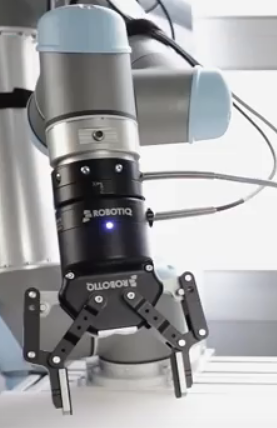
Hi @Chad354,
Here are my answers to your questions:
1) You can use as many snapshot positions as you like in your program. Those snapshot positions are saved in the robot's installation file and can be used over different programs also.
2) With the Wrist Camera, you will need to teach your objects to it. When doing so, the camera will build a model of the part in order to perform part detection at run-time. The best objects to teach are parts with a quasi-flat top that contains distinctive features. Those features are what the model will be built of. The camera detects contrasts in colors in order to build the model. You can refer to this post to know more about how the camera handles color contrasts. Reflective parts can be difficult to teach. Reflections will be seen as features on the part. You can use a method like the one described here to manage this.
3) When you define a snapshot position, there is a wizard that will guide you through a calibration procedure for this specific snapshot position in regards to your work plane. For good results, the parts you teach using a snapshot position must be on the same work plane that has been calibrated. You can use different snapshot positions in your program, thus using as many different work plane.
4) As mentioned, the snapshot positions are saved within the robot's installation file. Thus, a snapshot can be used in as many programs as you like, as long as they are built with the same installation file.
5) Yes, the FT sensor and 2-Finger Gripper can be mounted along with the Wrist Camera. The camera can actually replace the gripper's coupling. The three devices together on a UR look like so (the Wrist Camera being in the middle):

Feel free to post further questions or comments below!

 Annick_Mottard
Annick_Mottard
Hi Everyone,
We have an assembly project I'am considering using a UR and wrist camera for. The basic sequence would be to locate and pick component 1, then locate component 2 and assemble component 1 to it. Then locate and pick component 3 and again locate component 2 and assemble component 3 to it.
I have no first hand experience with the wrist camera and I have a few questions(I'm sure more are to come).
1) How many different snap shots can be used in a single program?
2) These parts come in various shades of whites, browns, and blacks and matte and gloss finishes. How sensitive is the wrist camera to changing colors/finishes?
3) For best results all components would need to be on the same plane as the calibration board, correct?
4) If different snapshots are needed for different programs will the snapshots be re-called when the robot program is loaded or will they need to be re-taught each time a job is set up?
5) Can the F/T sensor, 2 jaw gripper and camera be used on the UR at the same time?
Thanks for the help.